Alpheus and Arethusa, Battista Di Domenico Lorenzi at the Velez Blanco Patio
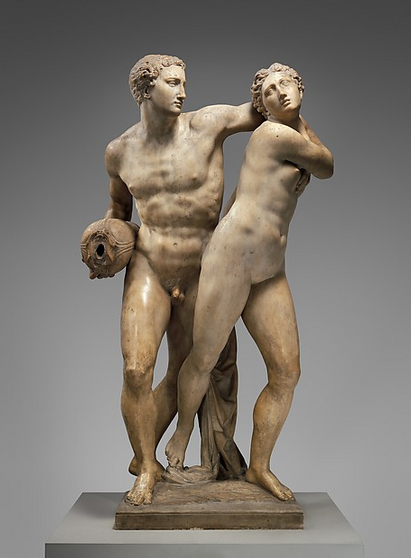
Alpheus and Arethusa is a marble sculpture created by Lorenzi during 1568-70. The height of the sculpture is 58 5/8 inches, width is 32 5/8 inches and depth is 23 ½ inches. The sculpture weighs 782 pounds. It was designed for a garden owned by Alamanno Bandini. It was initially erected in his villa near Florence.
According to Roman mythology, Arethusa was the daughter of Nereus. The literal meaning of Arethusa is “the waterer” and the tale on which this sculpture of Alpheus and Arethusa is based, has its origin in a river. Mythology suggests that one day when Arethusa was having a bath in a river, Alpheus, the river God, expressed his love for her. Arethusa was not interested in his advances because she wanted to remain chaste in her worshipping of Artemis.
She got frightened and tried to flee from there. When she noticed that Alpheus was continuously pursuing her, she requested Goddess Diana (Artemis) to come to her rescue. Diana responded back and transformed Arethusa into a cloud, but since she was very frightened, she started perspiring and as a result, took the form of a stream. She (in the form of a stream) travelled underground and appeared at the island of Ortygia. Alpheus followed her and mingled with her waters (Remington, 1940).
The sculpture being discussed is a depiction of Alpheus and Arethusa in an arrested position. Alpheus is shown trying to hold Arethusa with his left hand while she attempts to get herself free from the tangle. Arethusa is shown holding her clothes in her left hand; probably she might have taken them off in order to have a bath. Alpheus is shown holding a vase in his right hand; the vase is believed to be a source of water (Wardropper, 2011).
This sculpture might seem to be static but actually it was the sculptor’s initiative towards depicting figures in motion. Lorenzi depicted both Alpheus and Arethusa as if they were moving forward. Alpheus is shown to be moving forward while Arethusa is diverting sideways. The sculptor used checks and balances to create the sculpture. Alpheus’s chest is facing the viewer while Arethusa is standing diagonally. While Alpheus is looking towards Arethusa, she, in an attempt to look towards Aretheus, is facing the viewer.
Lorenzi has aptly depicted the emotions of both the figures and that too in accordance to the mythological story. Alpheus’s expression is that of a person making an earnest attempt to persuade his lady love. He is looking towards Aretheus in a very loving manner. On the other hand, Aretheus’s expression is that of a person pleading someone for help. She is probably requesting Alpheus not to follow her and at the same time she might be requesting Goddess Diana to rescue her.
Further, Lorezi has depicted clothes in Aretheus’s hands, which makes us believe that she has taken them off to have a bath. The vase in Alpheus’s hand gives us an idea of his being the river God. According to Wardropper (2011), “… in his right hand Alpheus holds an up-ended vase, the conventional emblem of a river God, from which water once flowed into the basin below” (p. 89).
Also, Alpheus’s strong built is an indication of his being some powerful personality; Aretheus is shown to have a tender body. The sculpture suggests that Alpheus has caught Aretheus and is trying to restrain her from running. The posture of Aretheus’s legs depicts her action of running. The sculpture portrays the exhilarating moment just before the transformation of Aretheus.
The sculpture was apt for the purpose for which it was made. It was erected on a high base behind a huge basin in a decorated grotto. The picture below depicts the grotto where this sculpture was initially installed.
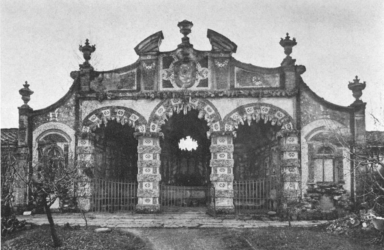
Orpheus, Cristoforo Stati (Cristofano Da Bracciano)
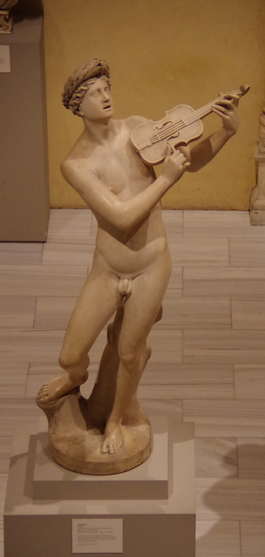
Orpheus is a marble sculpture created by Cristoforo Stati during 1600-01. The height, width and depth of the sculpture are 77 1/8, 38 and 23 7/8 inches respectively. The sculpture was specially made for Palazzo Corsi.
According to Greek mythology, Orpheus was a musician. His caliber was such that he could lure both humans and animals with the same intensity; not only this, he could charm trees and lifeless things as well. Mythology suggests that once while Orpheus’s wife, Eurydice, was being pursued by her would be paramour, she was bitten by a poisonous snake that resulted in her death.
Orpheus was grief stricken and decided to bring his wife back to life with the power of his music. He entered Hades and persuaded Pluto to allow him to take his wife back to earth. Pluto gave in to his pursuance but on a condition that Orpheus would not look back at his wife (who would follow her) until he reached earth. However, out of curiosity, Orpheus looked back to confirm that his wife was following him. At this instance, his wife disappeared and since then his only relief was music (Metropolitan Museum of Art, 1987).
The sculpture depicts Orpheus as a personification of music. He is shown playing a “lira da braccio” and donning a “laurel crown”. Such a crown was awarded to winners of poetry and music contests in ancient Greece. This again confirms the mythological assertion that Orpheus was a musician. The sculptor has successfully been able to link the mythological story with his work.
The sad expression of Orpheus in this sculpture is clearly visible. According to the mythological story, after the death of his beloved wife, Orpheus played his music instrument in order to plead Pluto to send her back. The pain experienced by Orpheus at that time is reflected on his face in the sculpture.
A Siren, Anonymous Sculpture
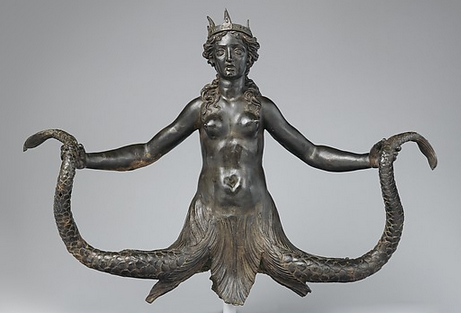
Siren is a bronze sculpture carved by an anonymous carver during 1571-90. The sculpture is 32 1/8 inches high, 44 ¾ inches wide, 13 3/8 inches deep, and weighs 130 pounds.
The statue depicts a nude woman who seems to be aquatic towards lower part of her body. She is holding a scaly tail each in both her hands. Her long hair takes the shape of gills towards the end.
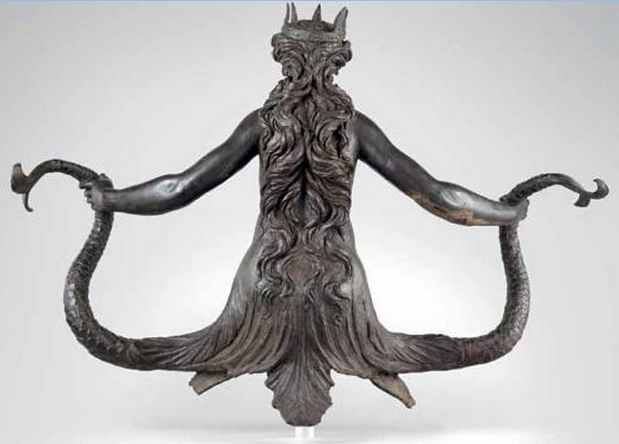
The statue is shown wearing a crown; it is believed that this crown was added at a later stage probably due to loss of the previous one. This assumption emerges from the fact that the upper part of her head (pate) is flat and even her cranium (part of skull) is kept open in order to hold a crown (Wardropper, 2011). The crown gives an impression that the person depicted in the statue must have been from some specific dynasty of high stature.
The statue was so popular during that time that one of the greatest families of Rome, the Colonna, made it their symbol. Owing to such adaptation, the statue was erected at various significant places such as on their tombs, ceilings, and furniture. Wardropper (2011) claims that, “A siren appears on his armour in a painting and tops two rostral columns on a stone relief memorializing the victory at Lepanto” (p. 90). Here, Wardropper is referring to the conquest of Marcantonio Colonna over the Turks.
Wardropper (2011) suggests that the statue would have given a better impression had it been installed on a column since a round column like structure was earlier a family symbol of the Colonna family. In such a case, the gills of the statue would have wrapped the column in a circular manner. Such a structure would have been more appealable from a distance.
Inspiration From Michelangelo’s Sculptures
Michelangelo di Lodovico Buonarroti Simoni, usually referred to as Michelangelo, was also a famous sculptor from the 16th century but his sculptures were made earlier than the aforementioned ones. He is regarded as one of the greatest sculptors of all times. Most of his works (that include paintings and sculptures) are considered to be the best among the existing ones.
Previous work is always an inspiration for further development. Moreover, Michelangelo’s work depicts characters from various walks of life. He portrayed them according to their profession, stature and beliefs. The sculptures mentioned in this paper namely, the Alpheus and Arethusa, the Orpheus, and the Siren can be compared to Michelangelo’s statue of David (shown below).
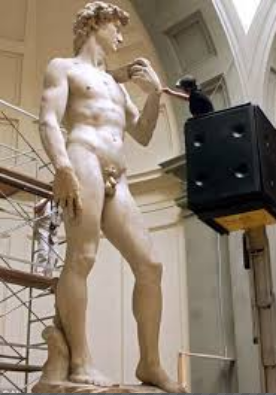
Firstly, likewise Michelangelo’s the David all the three sculptures are depicted nude. The structure of the body of the David resembles those of Alpheus and Arpheus. All of them are shown to be well built. The only difference seems to be the size of the sculptures. While Michelangelo’s the David stands tall at 14 ft, the other two look miniature; Alpheus and Arethusa is almost 4.75 ft tall and the height of Orpheus is around 6.5 ft. Secondly, the medium of most of Michelangelo’s sculptures was marble.
In this regard, Alpheus and Arethusa and Orpheus qualify to be influenced by Michelangelo’s work. A third resemblance that is noticed among the works of Michelangelo and those mentioned in this paper is that all the characters are holding something in their hands. While David is shown holding a sling shot, Alpheus holds a vase and Orpheus holds a playing instrument. Likewise the sculptures discussed in this paper, Michelangelo’s sculptures also relate to some mythological stories.
Like for instance, the David is depicted holding a sling shot (ready to fight). The position of his legs also suggests that he is very impatient to move forward. The stress on his face is clearly visible. All these sculptors have been able to successfully depict the expressions of their characters (as per mythological tales). Considering all such points, it is evident that the sculptures discussed in this paper were actually inspired by the works of Michelangelo.
References
Metropolitan Museum of Art. (1987). Renaissance in Italy and Spain. New York: Metropolitan Museum of Art.
Remington, P. (1940). Bulletin of the Metropolitan Museum of Art. JSTOR, 35(3), 61-65.
Wardropper, I. (2011). European sculpture, 1400-1900. New York: Metropolitan Museum of Art.